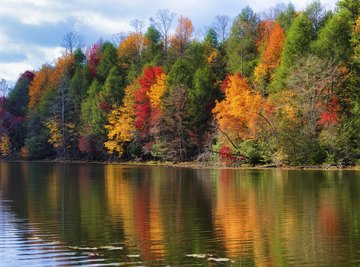
Biomes are biological communities of the earth classified according to the predominant vegetation and characterized by adaptations of organisms to that particular environment. Freshwater biomes are characterized by the extremely low salt content of the water. Abiotic factors are the non-living components that form the environment in which the organisms subsist in freshwater biomes. These include the chemical and physical environmental factors such as sunlight, temperature, water or moisture and soil. Fresh waters are found in lakes, ponds, rivers and streams and the biomes are maintained by precipitation.
Temperature
Temperature plays an important role in freshwater biomes. Depending on the season, temperature may be uniform or disparate between different layers of ponds and lakes. During summer, the temperature at the top could be 22 degrees C while the bottom temperature can be around 4 degrees C. During the winter, the temperature at the top could be at freezing point of water (0 degrees C) while the bottom can be at 4 degrees C. In the thermocline, which is the zone between these two layers, the water temperature changes continuously. During the spring and fall seasons, because of winds, the top and bottom layers mix with each other which results in regularization of temperature around 4 degrees C. This mixing results in oxygen circulation throughout the lake. Mixing is less prevalent during winter.
Precipitation
Precipitation is responsible for replenishment of water in freshwater bodies. Water cycle plays an important role in this respect. Depending on their size, rivers and lakes affect the climate. They are responsible for the presence of moisture in air. This moisture or water vapor forms clouds and precipitates over land as rain. In winter this may be in the form of snow. Precipitation plays an important role in maintenance and creation of freshwater biomes. While some water or snow seeps into ground to form groundwater, remaining water runs over the surface of the land and flows back to freshwater biomes.
Water Characteristics
Water characteristics such as depth and whether the water body is static (non-moving) or dynamic (moving) distinguish freshwater biomes. Rivers and streams are moving freshwater. Younger rivers cut a straighter and direct path through the ground and rock. Older rivers and streams follow more curves, which makes their flow slower. Lake or pond water, on the other hand, is static. Even though lake water is static, it moves and water waves are formed because of air flow. Seasonal changes also move lake water. In autumn, the surface water cools down and sinks. The bottom layers move up. This phenomenon is called turnover. This regularizes the temperature in the lakes.
References
- Biomes: Fresh Waters; Linda Aspen Baxter; 2007
- Earth’s Biomes: Rivers, Streams Lakes, and Ponds; Barbara A. Somerville; 2004
- University of California Museum of Paleontology: The World's Biomes
Resources
About the Author
Debashree Sen is a technical writer and has written for non-profit organizations. She has been regularly contributing to eHow since 2009. She is a member of the Society for Technical Communication (STC). She has a master's degrees in professional writing and English literature.
